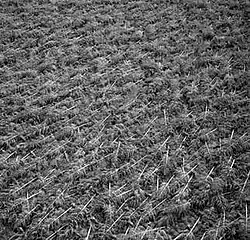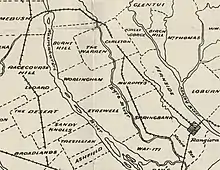Eyrewell Forest | |
|---|---|
 Destruction of the forest the area is named after on 1 August 1975 | |
| Coordinates: 43°25′S 172°19′E / 43.42°S 172.31°E | |
| Country | New Zealand |
| Region | Canterbury |
| Territorial authority | Waimakariri District |
| Ward | Oxford-Ohoka Ward |
| Community | Oxford-Ohoka Community |
| Electorates |
|
| Government | |
| • Territorial Authority | Waimakariri District Council |
| • Regional council | Environment Canterbury |
| • Mayor of Waimakariri | Dan Gordon |
| • Waimakariri MP | Matthew Doocey |
| • Te Tai Tonga MP | Tākuta Ferris |
| Area | |
| • Total | 272.11 km2 (105.06 sq mi) |
| Population (June 2023)[3] | |
| • Total | 2,070 |
| • Density | 7.6/km2 (20/sq mi) |
| Time zone | UTC+12 (NZST) |
| • Summer (DST) | UTC+13 (NZDT) |
| Postcode | 7476 and 7495 |
| Area code | 03 |
| Local iwi | Ngāi Tahu |
Eyrewell Forest is a small rural area in the Waimakariri District, New Zealand.
Etymology
During the 1920s, kānuka was replaced with plantation forestry.[4] The name "Eyre" used for many geographic features in the wider area refers to Edward John Eyre who was Lieutenant-Governor of New Munster Province from 1848 to 1853. Eyrewell was named by an early settler, Marmaduke Dixon, when he found much-needed groundwater on his property.[5] With about half of the area in exotic pines, the "Forest" part of the name derived.
History
Due to Canterbury's lack of native forest, in the early 1900s the government planted exotic forests throughout North Canterbury, including Eyrewell Forest. On 1 August 1975, however, most of the forest was blown over by strong north-westerly winds. The area's Pinus radiata plantation is the only place on earth where the critically endangered Eyrewell ground beetle can (or could) be found.[6] As of January 2019, the plantation has been almost entirely cleared by local iwi Ngāi Tahu, with the intention of converting it into intensive dairy farms. Despite protests by Department of Conservation, it is thought that the rare Eyrewell ground beetle has become extinct as a result.[4] There is also considerable concern over the large environmental impact this will have in the area, considering its proximity to the Waimakariri River and the area's dry conditions.[7]
Demographics
The Eyrewell statistical area covers 272.11 km2 (105.06 sq mi).[2] It had an estimated population of 2,070 as of June 2023,[3] with a population density of 7.6 people per km2.
| Year | Pop. | ±% p.a. |
|---|---|---|
| 2006 | 918 | — |
| 2013 | 1,521 | +7.48% |
| 2018 | 1,806 | +3.49% |
| Source: [8] | ||

Eyrewell had a population of 1,806 at the 2018 New Zealand census, an increase of 285 people (18.7%) since the 2013 census, and an increase of 888 people (96.7%) since the 2006 census. There were 627 households, comprising 900 males and 906 females, giving a sex ratio of 0.99 males per female. The median age was 38.4 years (compared with 37.4 years nationally), with 399 people (22.1%) aged under 15 years, 291 (16.1%) aged 15 to 29, 966 (53.5%) aged 30 to 64, and 150 (8.3%) aged 65 or older.
Ethnicities were 90.9% European/Pākehā, 9.1% Māori, 1.3% Pasifika, 4.8% Asian, and 3.2% other ethnicities. People may identify with more than one ethnicity.
The percentage of people born overseas was 22.1, compared with 27.1% nationally.
Although some people chose not to answer the census's question about religious affiliation, 59.0% had no religion, 30.6% were Christian, 0.2% had Māori religious beliefs, 0.2% were Hindu, 0.7% were Muslim, 0.3% were Buddhist and 2.3% had other religions.
Of those at least 15 years old, 261 (18.6%) people had a bachelor's or higher degree, and 210 (14.9%) people had no formal qualifications. The median income was $43,500, compared with $31,800 nationally. 333 people (23.7%) earned over $70,000 compared to 17.2% nationally. The employment status of those at least 15 was that 858 (61.0%) people were employed full-time, 213 (15.1%) were part-time, and 33 (2.3%) were unemployed.[8]
Climate
The average temperature in summer is 16.2 °C, and in winter is 5.9 °C.[9]
| Month | Normal temperature |
|---|---|
| January | 16.8 °C |
| February | 16.3 °C |
| March | 14.6 °C |
| April | 11.6 °C |
| May | 8.3 °C |
| June | 5.8 °C |
| July | 5.3 °C |
| August | 6.5 °C |
| September | 8.9 °C |
| October | 11.2 °C |
| November | 13.3 °C |
| December | 15.5 °C |
References
- ↑ "Electorate Boundaries". Archived from the original on 8 February 2013. Retrieved 29 November 2013.
- 1 2 "ArcGIS Web Application". statsnz.maps.arcgis.com. Retrieved 30 August 2021.
- 1 2 "Population estimate tables - NZ.Stat". Statistics New Zealand. Retrieved 25 October 2023.
- 1 2 Hancock, Farah (13 February 2019). "Hello cows, bye-bye rare beetle". Newsroom. Retrieved 15 February 2019.
- ↑ Reed, A. W. (2010). Peter Dowling (ed.). Place Names of New Zealand. Rosedale, North Shore: Raupo. p. 119. ISBN 9780143204107.
- ↑ Brockerhoff, Eckehard G.; Berndt, Lisa A.; Jactel, Hervé (2005). "Role of exotic pine forests in the conservation of the critically endangered New Zealand ground beetle Holcaspis brevicula (Coleoptera: Carabidae)". New Zealand Journal of Ecology. 29 (1): 37–43.
- ↑ Chalmers, Heather (30 October 2018). "Ngāi Tahu Farming replaces forestry with 14,000 cows at Eyrewell". Stuff. Retrieved 20 November 2019.
- 1 2 "Statistical area 1 dataset for 2018 Census". Statistics New Zealand. March 2020. Eyrewell (313500). 2018 Census place summary: Eyrewell
- ↑ "Weather statistics for EYREWELL FOREST, Canterbury (New Zealand)". yr.no. Retrieved 28 November 2013.